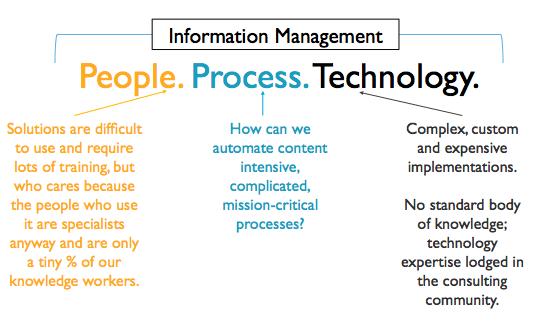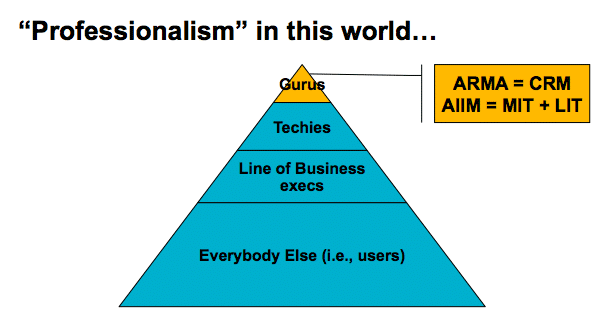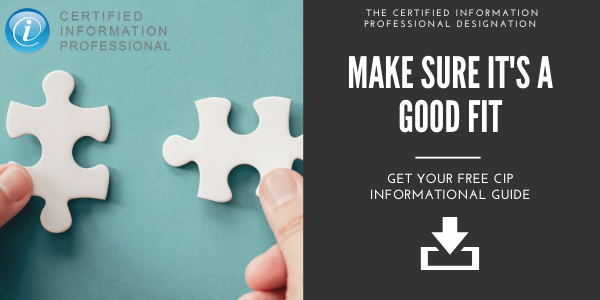
A Short History of Where Information Professionals Came From
Intelligent Information Management (IIM) | Certified Information Professional (CIP)
Many people do not realize that AIIM was founded in 1943 as the National Microfilm Association. Many people are mystified about how an organizational journey could somehow begin in 1943 with microfilm, and wind up in 2016 with content and information management.
So what is the connective tissue in this strange story?
I think it boils down to 3 words: People, Process, and Technology.
Of course, what People + Process + Technology adds up to IF DONE RIGHT -- is intelligent information management, which is what AIIM is all about. The reason I say “If Done Right” is that over the course of managing this triad, organizations have tended to get parts of this equation right, but seldom do they get all three working in sync. Which is why there is so must frustration out there. I happen to think that an “Information Professional” is the person that weaves this story together, but I’m getting ahead of myself.

Let me go through a very short pre-history of how we came to think there was even such a thing as an “information professional” in the context of this triad of PEOPLE and PROCESS and TECHNOLOGY.
From 1996 to 2006, the PROCESS questions we asked in our organizations centered around this fundamental question: “How can we automate content-intensive, complicated, and mission-critical processes?”
On the TECHNOLOGY side, most implementations in this period were complex and custom and expensive. There was no standard body of knowledge. Technology expertise was lodged in the consulting community. Looking over to the PEOPLE side of the equation, solutions were difficult to use and required LOTS of training. But nobody really cared because the people who used the solutions were specialists and were only a tiny percentage of the overall number of knowledge workers in our organizations.

“Professionalism” in this world was narrowly defined. If you think about the overall universe of knowledge workers, you can divide them into Gurus, Techies, Line of Business executives, and Everybody Else (in other words, those pesky end users). “Professionalism” in this world was defined principally by AIIM with its MIT and LIT designations (“Master” and “Laureate” of information technology) and by ARMA/ICRM with its Certified Records Management (CRM) certification. And the focus was on the tippy-top of the pyramid.

In this tight little world, something was missing. Even 20 years later, there are still less than 1,000 CRMs in the world. The CRM certification was (and still is) extremely valuable, but it only tapped into the surface of the education needed by technology and business people. There was clearly a need for industry-standard technology education, focused on standardizing the hodge-podge of consultant delivered training that was the norm in 2006.
In 2006, the nature of content, records, and information management training changed with the launch of AIIM’s ECM Practitioner, Specialist, and Master training programs. AIIM followed up its standardized ECM training with training in Electronic Records Management, Business Process Management, SharePoint, and a host of other content technologies. By 2010, the concept of “professionalism” was stretched to also include the “techie” and line of business communities via the AIIM designations.
In 2010, AIIM came to the conclusion that there was an opportunity to standardize an even broader body of knowledge under the concept of a “Certified Information Professional” or CIP.
AIIM’s original conception of what it meant to be an “information professional” was not unlike the definition of professionalism that came to be accepted in the 1980s and 1990s in project management. In the early stages of the professionalization of project management, if you had proposed that there was a common body of project management knowledge that could stretch across a wide variety of domains and industries, people would have thought you were crazy. “How could the project management knowledge to run a software project possibly be similar to that required to build a bridge or that required to construct a building?” In the course of the 1980s and 1990s, the Project Management Institute succeeded in establishing the PMP as the standard body of knowledge associated with project management across a wide variety of disciplines.
In its original conception, AIIM thought the CIP would become an “everyman’s” certification, relevant to gurus and techies and business people alike. The reality after 1,000 CIPs and six years is that it has come to signify something different.
The CIP has come to represent a badge of competency and knowledge at the top of the knowledge worker pyramid for those entrusted with the task of building an information STRATEGY in a time of digital disruption. Broader than Records Management and Information Governance, Information Professionals are charged with these questions:
Who owns the BIG PICTURE for how information is managed in our organization?
Who owns our information management STRATEGY?
Who can helps us treat information as the critical business asset it has become?
The accelerating pace of Digital Disruption makes this role more important -- and different -- than ever. But before going there, how exactly is the emerging era of Digital Transformation different from where we are now? More to come in the next post.
About John Mancini
John Mancini is the President of Content Results, LLC and the Past President of AIIM. He is a well-known author, speaker, and advisor on information management, digital transformation and intelligent automation. John is a frequent keynote speaker and author of more than 30 eBooks on a variety of topics. He can be found on Twitter, LinkedIn and Facebook as jmancini77. Recent keynote topics include: The Stairway to Digital Transformation Navigating Disruptive Waters — 4 Things You Need to Know to Build Your Digital Transformation Strategy Getting Ahead of the Digital Transformation Curve Viewing Information Management Through a New Lens Digital Disruption: 6 Strategies to Avoid Being “Blockbustered” Specialties: Keynote speaker and writer on AI, RPA, intelligent Information Management, Intelligent Automation and Digital Transformation. Consensus-building with Boards to create strategic focus, action, and accountability. Extensive public speaking and public relations work Conversant and experienced in major technology issues and trends. Expert on inbound and content marketing, particularly in an association environment and on the Hubspot platform. John is a Phi Beta Kappa graduate of the College of William and Mary, and holds an M.A. in Public Policy from the Woodrow Wilson School at Princeton University.


![[Informational Guide] Is certification right for you? Get this free CIP Exam Guide to find out.](https://no-cache.hubspot.com/cta/default/332414/dcb32a30-373b-4f1b-9d7f-90425213921c.png)
